I have four Viyella knitting needle gauges. They are basically the same but are all different. Some differences are more obvious than others.
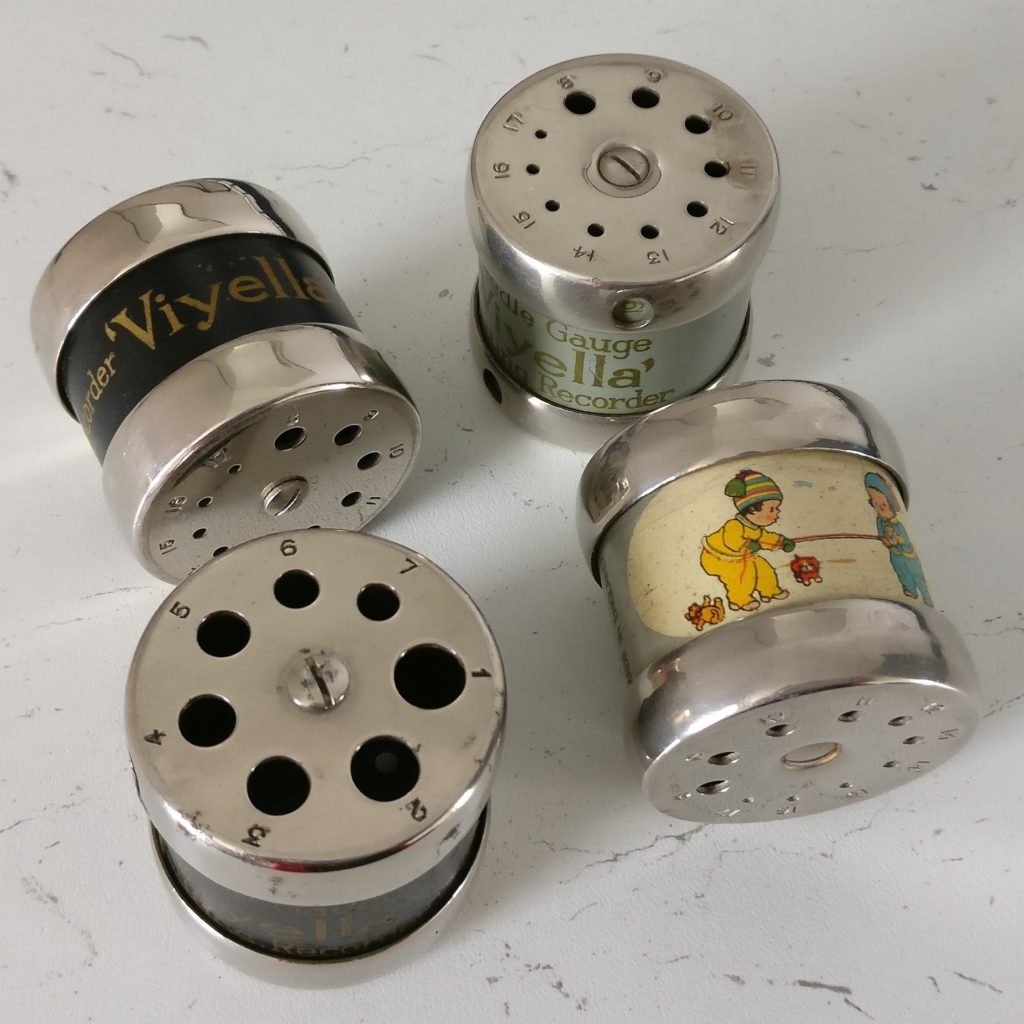
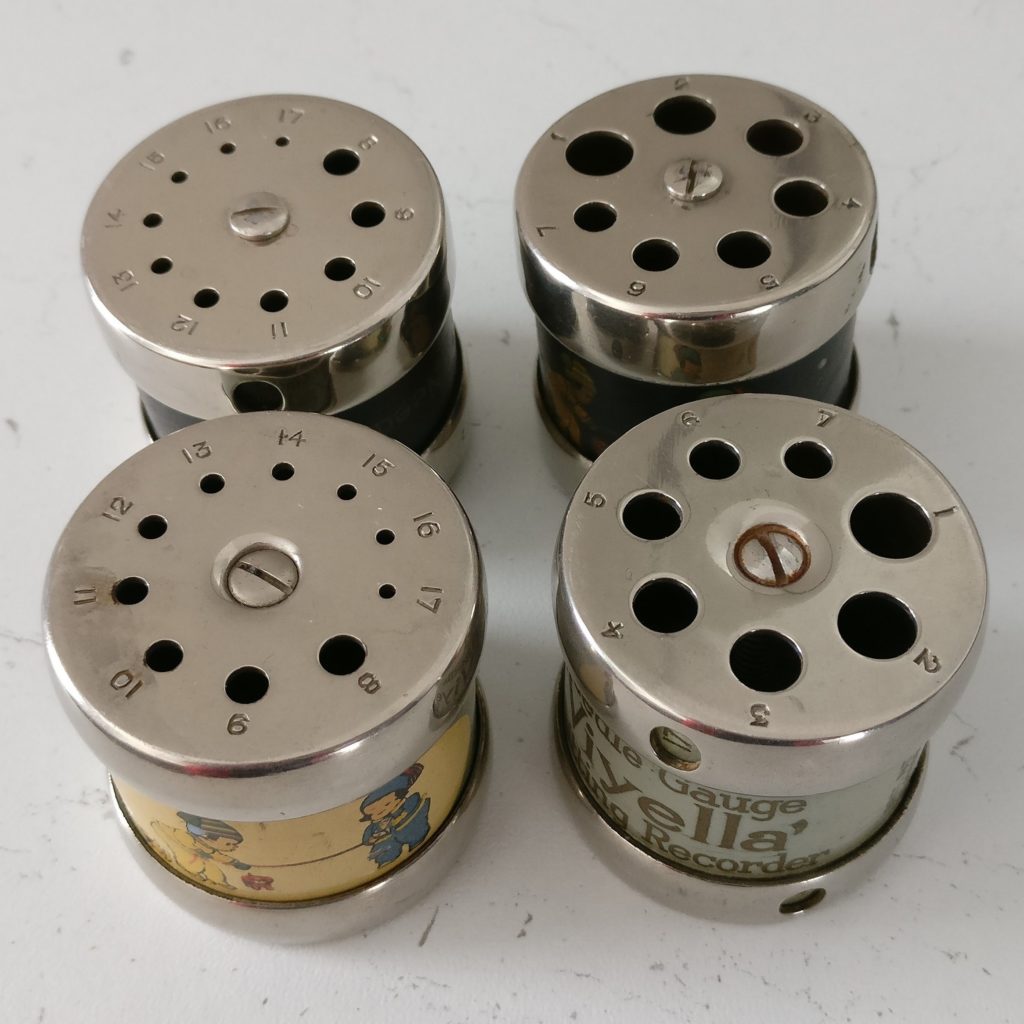
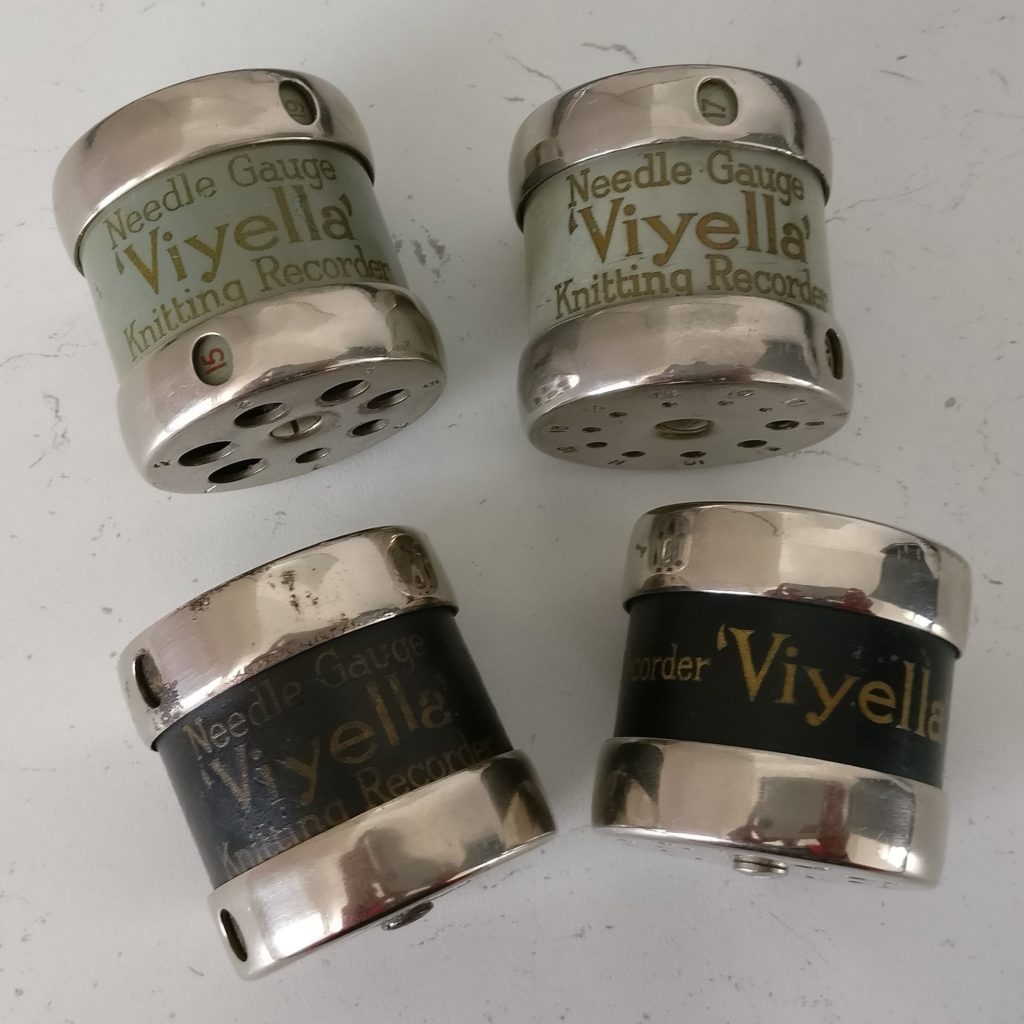
The same picture is on the back of three of the drums. It is of two children, in the style of Mabel Lucie Attwell but I cannot confirm that she was the artist.
The other drum has no picture. I have read that this was to save costs during WW2 but it seems unlikely that such an elaborate object would still be made only changing the printing.
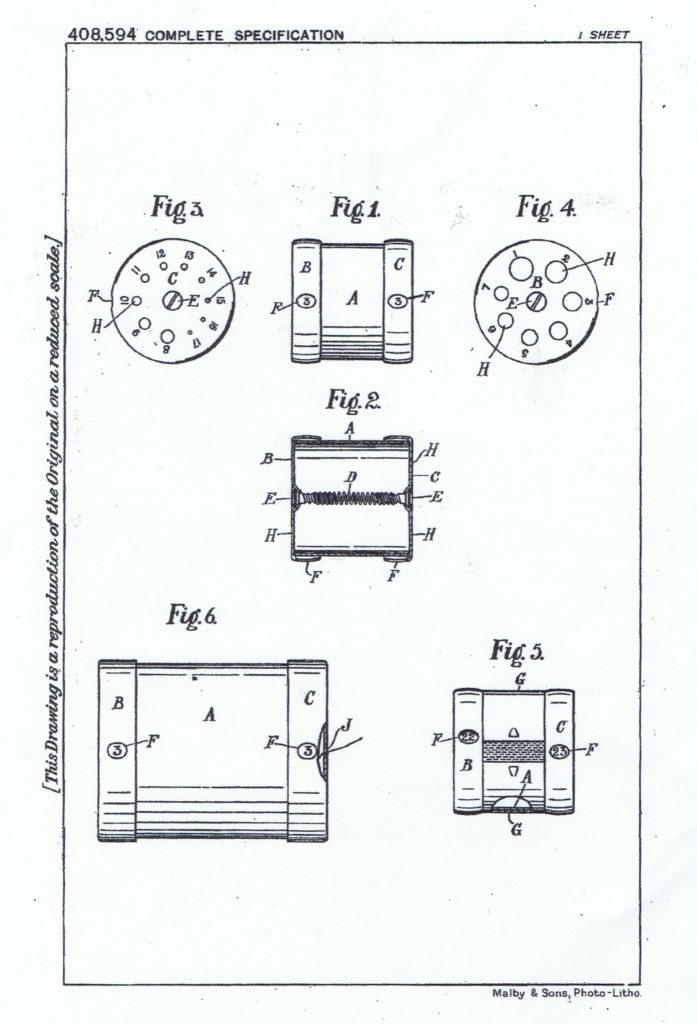
All are marked as Needle Gauge and Knitting Recorder. The sizes of the holes are 1 – 7 at one end and 8 – 17 at the other. In addition to the holes for measuring the needles, the top and bottom of the drums turn to reveal the numbers 1 – 24. These are for counting the rows, or anything else you want to keep track of. The two sets of numbers are in different colours so you know which is which.
The top and bottom are held in place by screws which are joined by a strong spring, leaving the shiny parts able to rotate.
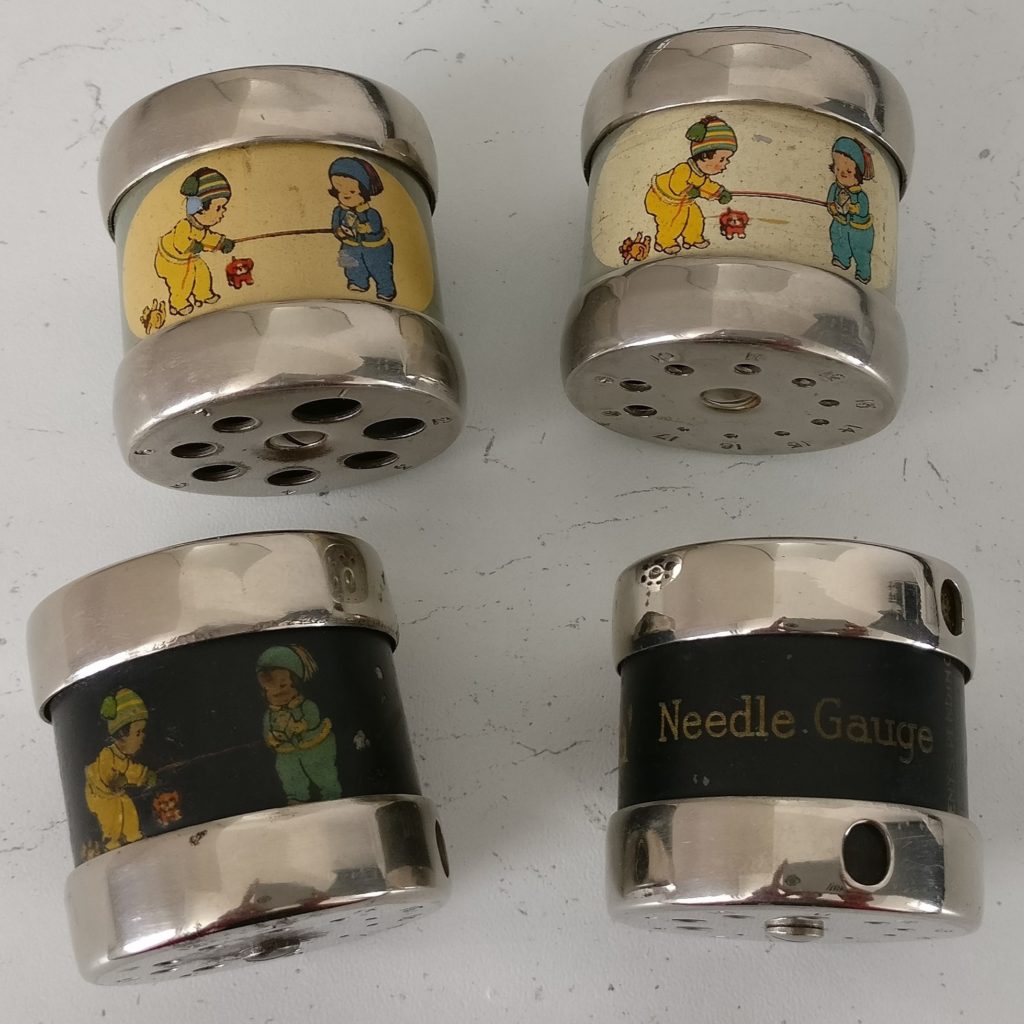
It is not possible to determine the exact date of these gauges but some were definitely made before others. The black one with the picture has nothing to suggest a date. The other black one and one of the others say Patent Pending. The fourth says Brit.Pat.No.408594
The application for the patent was made in 1932 and was accepted in 1934. This would suggest that two of these examples date from between 1932 and 1934 when the patent was still pending, one is from after 1934, the other is of an unknown date.
The application was from William Hollins and Company Limited and Horace Josiah Ball. Both of theses were from Nottingham. The final specification says:
This invention relates to improvements in number indicating devices for the use of knitters, or for use as a calendar, or for scoring points in a game, or for like purposes, and its object is to provide a convenient and inexpensive arrangement of the cylindrical type, the members of which can be more conveniently adjusted than in existing devices, and will not be likely to become accidentally displaced after being set.
According to this invention, the device comprises a hollow cylindrical casing of any convenient dimensions, with end covers of the pill box lid type which fit on the exterior of its ends These covers are angularly adjustable on the body, and numbers are disposed round either the ends of the body or the rims of the end covers, the relation of which numbers to a point on the other part being adjusted by turning !he end covers on the body.
A centrally disposed spring may be provided for holding the end covers on the body, and the several parts described are when the device is made on a small scale, preferably of thin sheet metal but a nonmetallic material may be used when the device is made of a large size.
The invention will now be more particularly described with reference to the accompanying drawing, in which Fig 1 is a front view, and Fig 2 a section of a number indicating device constructed according to our rue invention.
Fig 3 is a view of one end of the device, and Fig 4 a view of the reverse end.
Fig 5 is a front view showing an alternative arrangement
Fig 6 is a front view showing a construction which is large enough to hold a ball of yarn.
Like letters indicate like parts throughout the drawing.
Referring first to the arrangement shown in Figs 1 to 4, A is the cylindrical body, and B and C are the end covers which fit like pill box lids on the ends of the said body. If preferred, these two end covers B and C may in order to prevent them from becoming accidentally displaced, be connected by an interior spring D as shown in Fig 2. In this case each cover is formed with a central hole, studs E are located in these holes, and their inner ends are connected to the two ends of a centrally disposed spiral spring D which is in tension. In one arrangement, the rims of the covers B and C may have numbers engraved or stamped all round them, while the cylindrical body A has two points indicated thereon, that is, one near each end cover, and the two covers can be rotated to bring any of the numbers thereon into register with these points on the body and thus register the same.
In the preferred arrangement which is shown in the drawing, the numbers are engraved or stamped round the two ends of the cylindrical body A, in such a position-that they are covered by the rims of the end covers B and C, and each of the latter is formed with a single opening F so disposed, that by turning the end covers, each will expose one number on the body at a time.
In order to prevent confusion, the end covers B and C or the numbers on each end of the body A may be of different colours, and both of a different colour to the middle exposed portion of the cylindrical body A.
The provisional specification has more features for knitters but these are not included in the final, approved, patent.
The device may be used by knitters for recording the number of courses knitted, and the number of stitches knitted in the last course, or other information respecting the progress of the work, when the latter is laid down, so as to obviate the necessity for counting when the work is taken up again It can also be used for scoring points in games in which two players or two sides are taking part.
If desirable the portion of the body part between the two end covers may have narrow stripes of different colours or shades disposed thereon parallel to the axis of the body, and this part of the latter may be enclosed by an external rotary casing with a gap at one point in its circumference Each shade or colour can then be separately exposed to view by adjusting the gap in the outer casing in register with them, and the different shades or colours which can thus be seen disassociated from the remainder, may be numbered so that a record can be kept of any one, or a series of them for future reference. Other uses may be made of the device, for instance if months of the year are substituted for the colours, the device can be used as an adjustable calendar.
For the use of knitters, the end covers may be formed with a series of holes, which are graduated in size and are numbered so as to form a knitting pin gauge, and in some cases the device may be made large enough to hold a ball of yam that is being worked up, and this yarn is wound so that it can be conveniently withdrawn through an opening which is provided for the purpose, preferably in the centre of one of the end covers.
In this case the several parts constituting the device may be most conveniently constructed of a substance such as cardboard, or of composition, and owing to its increased diameter and the material used in its construction, the end cover connecting spring is not required to prevent accidental displacement of the end covers, when they have been once set.
Viyella was a well-known company in UK. It was owned by William Hollins, who started making woven fabrics in the 1890s. It is still known today as a high-end fashion brand. There is very little information to be found about its knitting yarns but these were certainly popular in the 1930s. A few patterns and magazine adverts can be found online. The V&A has a copy of Viyella Knitting Book No 3 which includes 71 patterns. William Hollins is listed as the publisher.
These look really good Pat and rather ingenious. Where did you find such treasures?
I don’t remember where any of them came from. I know I’ve had one for a very long time. We used to spend a lot of time scouring charity shops and boot sales so must have picked them up on our travels. That was about 15 years ago. I certainly didn’t pay the kind of prices you see on the internet now.
Thanks, I do that too. It’s more satisfying to unearth a treasure amongst tat than buying it when it’s already been discovered.
I was doing some research as I have one of these and came across your article. Very interesting! Mine is blue/grey, has the children and dog, and says Patents Pending. I knew what it was but to have this additional information is amazing. I’m in Canada and purchased it here for $13 Cdn. I would like to ‘pick your brain’ about another item I have which I believe to be sewing or knitting related so please send me an email and I’ll send you a picture if you wouldn’t mind. Much appreciated, thank you!
I think you got a bargain. They often sell for a lot more than that.
I have emailed you about the other item